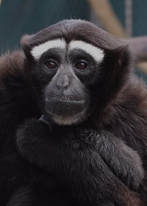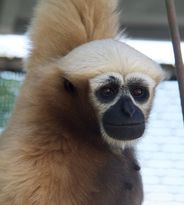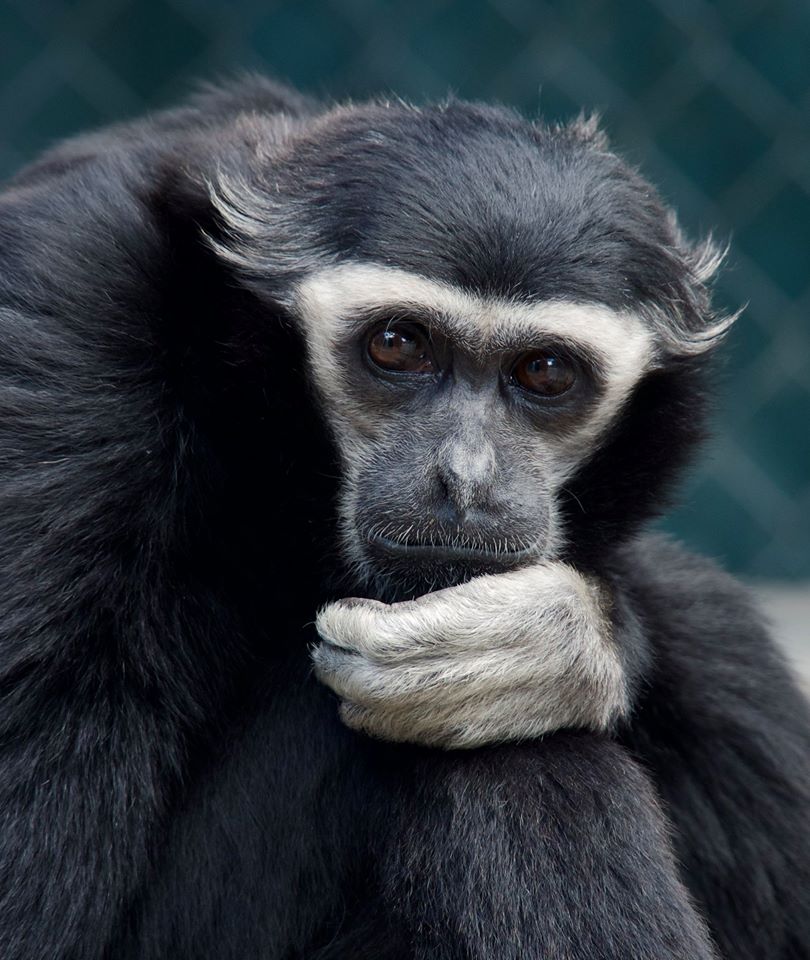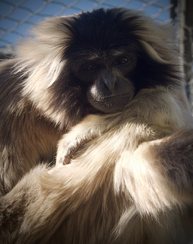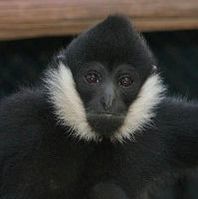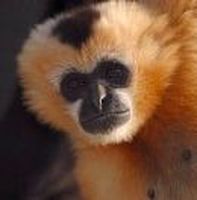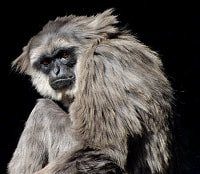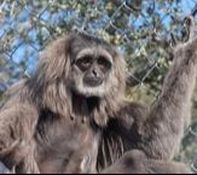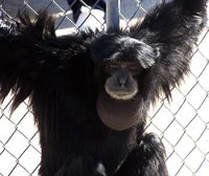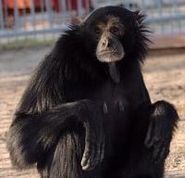Species at the GCC
Click here to see Individuals
|
Eastern Hoolock Gibbons
IUCN list : Vulnerable Wild # Native to Myanmar, NE India, Southern Yunnan China |
This species has 38 chromosomes and sing a duet. The name "Hoolock" is an onomatopoeia derived from the sound made when this species sings. The Gibbon Center is one of the few organizations that houses this species outside their country of origin.
GCC founder, Alan Mootnick, was involved with the discovery of their subgenus, and is credited with their renaming and elevation to genus level. Both males and females are blonde at birth in order to blend into their mother’s abdomen. At a year both males and females change fur color from blond to black. At seven females once again change colors. A fully mature female is a brownish-blonde with white rings around her eyes and mouth resembling a mask. A fully mature male has black fur with white eyebrows & goatee as well as a white testicle tuft. |
|
Pileated Gibbon
IUCN : Endangered Population Numbers : 30,000 Native to SE Thailand, Laos, Cambodia |
This species has 44 chromosomes. Their vocalization is produced with in-breath and out-breath tones. The female’s great call is one of the most spectacular vocalizations of all the gibbon species. It is close to impossible for a human to recreate the bubbling sound of the territorial song of the female pileated gibbon.
The word “pileated” means capped. Mature females have a dark cap and chest plate, which helps them to absorb heat in the cooler portion of the day. Males and females are born blond in order to blend in with their mom while holding onto her chest. They get a progressively patterned coat, which resembles that of an adult female. Sub adult males become darker until they have attained the black fur typical of adult males. This species is the most sexually dichromatic of all seven species in their genus. |
|
Northern White Cheeked Gibbon
IUCN : Critically Endangered Population Numbers : 1,000 Vietnam, Laos, China |
Their genus is known, as the crested gibbon, which has 52 chromosomes. All six species of crested gibbons are endangered, with numbers in the wild ranging from 25 Hainan gibbons (the world's rarest primate) to approximately 30,000 buff cheeked gibbons. This gibbon species is the rarest primate in the wild currently in a successful captive breeding program. There are more northern white-cheeked gibbons in North American and European zoos than in the wild in China and northern Vietnam.
Males and females are born light to blend in with their mothers once they are about a year old they begin to change colors. As juveniles they resemble an adult male White-cheeked gibbon all black with white cheeks. Females will remain this color throughout their adolescence. At seven years old females will change back to having light fur and in addition have a black crest on the top of her head. Pairs sing a duet with stark contrast in their song. While the males sing a long cry females sing a series of short chirps initiated by low oooo sounds. When males are young they sing the female part of the song not until they are around seven do they attempt the male part of the song. |
|
Javan
IUCN : Endangered Population Numbers : 4,000 Java Indonesia |
Their genus has 44 chromosomes. Unlike most gibbon species Javans do not sing a duet with their partners. Males and females sing two unique songs at different times. Males generally sing slightly before dawn while females sing a little later in the morning. They also make two distinct alarm calls one indicating a large bird and another indicating something on the ground generally a snake. While they may sing at the same time it is not a true duet.
Javans are also one of the few gibbons that are not sexually dichromatic meaning that both males and females are the same color. This also means they don’t undergo a color change, although when they are born their skin is pink and lacks pigment and changes to black as they are exposed to the sun. The eyelids are the last to change so babies might be entirely black and have pink eyelids visible only while they are sleeping. |
|
Siamang Gibbon
IUCN : Endangered Population Numbers : 200,000 Malaysia, Sumatra |
Siamang gibbons are the largest gibbon and the loudest land mammal. Siamangs have 50 chromosomes.
They exhibit unique paternal care not observed in other gibbons. "Symphalangus syndactylus" means webbing of the digits; the Siamang is the only gibbon species in which all individuals have partial webbing of their second and third toes. Siamang gibbons have a glossy black fur. However their most notable feature is their “gular sac” also known as throat sac. While not in use the sac simply resembles excess skin, which is sparsely haired. While singing, they will inflate this sac to help the song project through the forest canopy. Their throat sack inflates to the size of their head, with songs that can be heard up to 2 miles away. It is quite an interesting sound that resembles the echo heard when blowing air into a bottle. |
Gibbon Center |
Contact UsNon Profit Tax ID # 95-4256306
Physical Address: 19100 Esguerra Road, Santa Clarita, CA 91390 (Follow the GCC signs once you hit the dirt road) Mailing Address: PO Box 800249, Santa Clarita, CA 91380 Direct Line: 661-296-2737 E-mail Address: Info@gibboncenter.org |
Copyright © 2023 Gibbon Conservation Center. All rights reserved.

